#soil fertility
Text
Making Desert Land Fertile with Water Bunds

#permaculture#regenerative ag#regenerative agriculture#agriculture#farming#gardening#how to make soil more fertile#how to turn a desert into fertile land#soil#soil fertility#organic farming#organic gardening#water harvesting
2K notes
·
View notes
Text

Old school simplicity with new school flava.
#visionarygrowingsolutions#atlanta urban ag#compost#simple food small farmz#biodynamic#soil#biodiversity#soil biology#permaculture#urban ag#simplefoodsmallfarmz#simple food small farmz air bnb agriculture experience#small farmz simple food#simple food#simple things#soil fertility#soil food web#soil biodiversity#soil creation#atlanta airbnd experience#air bnb experience atlanta#atlanta air bnb urban agriculture experence#airbnb experience#maurice small
32 notes
·
View notes
Text
It’s so beneficial, peaceful and important.

#compost#biodiversity#soil health#bio char#urban ag#soil creation#permaculture#soil#soil science#maurice small#soil fertility#soil food web#vermicomposting#community composting systems#food sovereignty#polyculture#biodynamic
61 notes
·
View notes
Text
What's the difference between organic and chemical fertilizers?
When we buy fertilizers, they generally have NPK listed on the front, which gives the concentration of nitrogen, phosphorus, and potassium in the fertilizer. Organic fertilizers typically are sourced from plant or animal sources, while non-organic or chemical fertilizers are specific elements that we've determined plants need, and may have been synthesized in a lab or mined from the earth. Why might you favor one type of fertilizer over the other? It comes down to nutrient availability, which is a double edged sword. To understand why, we need to know a bit about mycorrhizal fungi.
Plants need nitrogen and other minerals, and when growing without excessive fertilizers, they form symbiotic relationships with ecto and endomycorrhizal fungi, which have vast mycorrhizal networks with incredible surface area. This allows the fungi to much more efficiently absorb minerals and water from the soil, which they exchange for plants' root exudates, which have sugars that the plants have fixed through photosynthesis. Plants with these symbiotic fungi are more resilient to disease and drought, and grow better. The mycorrhizal fungi can also reduce plant's uptake of heavy metals, and can prevent nutrient rich runoff.
When nitrogen, potassium, and especially phosphorus are too available, plants kick out their symbiotic fungi because they no longer need them to get these nutrients. However, this has a down side: symbiotic fungi protect against pathogenic fungi, so now those plants are more vulnerable to fungal infections. They also can no longer can take up water as easily, along with other micro nutrients that may or may not be in the fertilizer.
However, you may have noticed that I didn't specify chemical fertilizers in the above paragraph, and that is because you can see the same effect in some organic fertilizers, like manure, rock phosphate, bone meal, etc. So it's not JUST chemical fertilizers that can negatively impact fungi and their symbiotic relationship with plants- it's any fertilizer that is too rich and too available. If our goal is to support mycorrhizal networks, ideally we would add just enough fertility and in a form that is more available to fungi than plants, thus encouraging those symbiotic relationships.
However, that does not mean that chemical or readily available fertilizers don't have their place. If I'm growing something in a pot and it's going to be in a pot it's whole life, I'll often use some kind of fertilizer that I wouldn't use in my garden. Chemical or quick release fertilizers are great for when you've spotted a nutrient deficiency and want a quick turn around for your plants. I usually use some very rich sources of fertility for my cucurbits and raspberries, but learning this has made me rethink this practice.
I think an apt analogy between a box of strawberries and a soda. The box of strawberries has sugar, but it also has more micronutrients and will feed the kind of symbiotic bacteria we want in our gut in the long term. Meanwhile, the soda has a lot of sugar which will rapidly increase our blood sugar and feed the kind of bacteria that aren't as beneficial. However, if your blood sugar is crashing and you need to bring it up, the soda is the better choice. Each has their place, and it's best to analyze your situation and determine which is the better choice.
If you want to read more, here's some sources:
"A Gardener’s Primer to Mycorrhizae: Understanding How They Work and Learning How To Protect Them (Home Garden Series)" by Linda Chalker-Scott, available for free from WSU.
"The complete guide to restoring your soil Restoring your soil" a book by Dale Strickler, very in depth and a great book to read if you want to know more about soil.
This is a very complex topic and our understanding is expanding rapidly. I could not possibly cover everything there is to know about this in a single post, but I do think this is at least a good taste.
#soil#organic gardening#permiculture#regenerative agriculture#soil fertility#sustainable gardening#sustainable agriculture
102 notes
·
View notes
Text
Lupine Publishers | Battle Against Solid Waste: Contribution of University Belt Barangays Towards Clean and Disaster-Prepared City
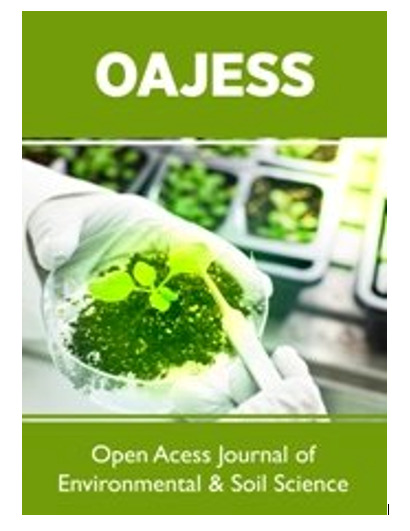
Abstract
Solid waste is one of the major problems in the urban communities due to congestion and improper garbage disposal. This problem may lead to some health and disaster-related issues. University Belt Area (UBA), a congested place in Manila City, Philippines generate tons of solid waste materials daily. Given this condition, it is significant to know the response of the local government units (LGUs) in addressing this type of problem. Thus, this study investigated the solid waste management programs (SWMP) implemented by UBA barangays and its problems encountered in implementing the said programs. The awareness of the residents on SWMP and their suggestions for effective implementation of these programs were also determined. An in-depth interview was conducted among barangay officials. Small group discussion (SGD) was conducted among the selected residents. Thematic analysis was used to interpret the qualitative data while descriptive statistical tools were used to analyze the quantitative data. Findings revealed that programs implemented by ten barangays in UBA are categorized into educational, infrastructure, waste reduction, and regular cleaning activity. These programs are known to most of the residents who participated in the study. In the process of implementation, the LGUs are facing some constraints. These constraints include lack of discipline among the residents, lack of funds, irregular collection of waste materials, location of the barangay, and poor segregation practices. To effectively implement the afore-mentioned programs, the residents suggested some important recommendations. These encompass implementation of the appropriate barangay resolutions, raising public awareness, and imposition of penalties for the violators. Stakeholders should provide strong support for SWM agenda of UBA barangays. Policy makers should consider these data to formulate sound policies which can address the problems on solid waste. The barangay council should review Republic Act 9003 and consider collaboration with Ferris Wheel Project for better implementation of the programs.
Keywords: Barangays; Solid waste; Solid waste management programs; University belt area; Urbanized areas
Introduction
Every day the world is getting more urbanized. The rate of urbanization is increasing at an alarming rate. United Nations Department of Economic and Social Affairs (UNDESA) reported that 34% of the world’s total population in 1960 was living in the urban centers. In 2014, this rate increased to 54% [1]. This increase in urban population is brought by the natural increase due high fertility rate of the urban population and rapid rural to urban migration [2]. The rapid rate of migration is attributed to the pull factors inherent to the urban environment itself [3] like better job opportunities, access to health and educational facilities, and high standard of living. University Belt (U-Belt) area (Figure 1) in Manila, Philippines (Figure 2) is an area where colleges and universities are concentrated, hence the name implies. This area is the home of more than fifty higher educational institutions. The Central University Belt (CUBE) area is a seat for twenty universities and colleges. As Filipinos put a high regard for quality and responsive education, population over in this place has increased tremendously. This rise in population then is considered as contributing factors in the escalation of the amount of waste materials generated in the urban setting. According to National Solid Waste Management Commission Reports (2015). the estimated the amount of solid waste generated in 2010 in Manila City alone was 2,990,814 metric tons. In 2014, this figure increased to 3,595, 593 metric tons. There is, however, no specific information that pertains to the case of U-Belt area.
The rise in population in the U-Belt area also resulted to the emergence of additional commercial establishments, dormitories, and other infrastructure development. This infrastructure development resulted to changes in the land use and the increase in the urban surface sealing which increases the amount of surface run-off and decreases the ground water recharge [4]. This condition serves as a challenge to the Local Government Units (LGUs) on how to deal with this problem. The problems on improper waste management and high percentage of impermeable land make U-Belt area highly vulnerable to the devastating effects of flood. High amount of waste materials and improper disposal of these items make people highly prone to the diseases (National Solid Waste Management Commission Reports, 2015) [5]. From the prevailing condition of this place, the researchers came up with the framework on the goals of the implementation of solid waste management programs in U-Belt area (Figure 3). The current modified framework focuses on how the dirty, disaster-prone, and disorder U-Belt area can be converted into clean, disaster-prepared and orderly place (Figure 1). This framework was modified from the framework of Discipulo [6] on urban renewal study.
From the existing problems on solid waste management in the U-Belt area, this study investigated the contribution of the U-Belt barangays towards a clean and disaster-prepared city. Specifically, this study determined the solid waste management programs implemented by the barangays around the University Belt, identified the problems encountered by the communities pertaining to the implementation of the programs, determined the awareness of the residents in the said programs, and identified the suggestions of the residents for effective solid waste management programs implementation. Data obtained from this study is vital in policy making and urban planning of LGUs. This will also agitate the stakeholders to support and participate in the program implementation.
Materials and Methods
Research design
The research design employed both descriptive and qualitative approaches. Qualitative research aims to interpret meanings, descriptions, and symbols [7]. The goals of this type of research are to provide answers to the why’s and how’s. On the other hand, descriptive approach was used to describe characteristics of the population being studied [8]. This approach answers the question of “what” in the study. Objectives 2 and 4 were answered using qualitative approach while objective 3 was answered using descriptive method. Both qualitative and descriptive approaches were used to answer objective 1.
Research locale
The study was conducted in the U-Belt area. The name was given to this area because of the high concentration of the colleges and universities in this place. Originally, this name was given only to San Miguel district but technically it includes the nearby districts such as Quiapo, Santa Cruz. This area covers Mendiola Street, Morayta Street (now Nicanor B. Reyes Street), eastern end of Azcarraga Street (now Recto Avenue), Legarda Street, western end of España Boulevard, and the different side streets (Figure 4). This study covers the 10 barangays as given in Table 1.
Respondents of the study
The participants of the study were the 7 chairperson, 3 barangay councilors, and randomly selected residents of the ten barangays in the U-Belt Area. Ten barangay chairpersons and several barangay councilors were asked about the solid waste management programs implemented by their respective barangays and the problems they encountered during the implementation of the said program in an in-depth interview. The councilors interviewed in this study were the heads of the committee on health and sanitation. Selected residents were asked about their awareness on solid waste management programs of their respective barangays and their recommendations for effective implementation of the said programs during the small-group discussion (SGD).
Research instruments
Two research instruments were used to gather the data needed in this study. These instruments were the interview guide questions for in-depth interview and guide questions for small group discussion. The contents of these instruments were validated by the experts in the field of research and solid waste management.
Data collection procedure
In order to gather the data needed for the study, the researchers did an in-depth interview with the barangay chairpersons and barangay councilors, focus-group discussion with the randomly selected residents, and regular observation was also conducted to validate the results. The methods in the in-depth interview and small group discussion were patterned from the suggestions of Yukalang et al. [7]. The items in the questionnaires were based from the ideas of Yukalang et al. [9] and McAllister [10].
In-depth interview
An in-depth interview with eight barangay captains, 1 barangay councilor, and 1 barangay secretary was conducted by the researchers to determine the solid waste management programs implemented by the barangays around the U-Belt area and the problems encountered by the communities in the process of implementation of the said programs. The researchers prepared the guide questions for interview ahead of time. The guide questions were validated by the expert in the field of research and environmental issues and concerns. The English version of the guide questions was translated into Tagalog so that the respondents can understand better and they can freely engage in the conversation. The researchers asked permission to record the conversations from the barangay captains, barangay councilor, and barangay secretary. Field notes were also utilized to record pertinent information during the interview.
Small group discussion
Eight small group discussions were conducted during the duration of the study. The number of participants and date of discussion in the selected barangays in the U-Belt areas during the discussion are reflected in Table 1. The demographic profile of the participants such as age, occupation, and highest educational attainment were noted during the onset of the activity. Each participant was asked regarding his/her awareness about the implemented solid waste management programs in his/her barangay.
Observation
In order to counter-check the information disclosed by the barangay chairpersons and councilors, regular observations were conducted by the researchers. A weekly observation on the implementation of the solid waste management programs and the difficulties associated with the implementation of these programs was done from March to September 2017.
Data analysis procedure
After the collection of data, the data gathered were analyzed using descriptive statistical tools and thematic analysis. The quantitative data were interpreted using the descriptive statistical tools such as frequency counts and relative frequency. Meanwhile, the qualitative data were analyzed using thematic analysis. In this method, patterns or themes within data were identified, analyzed, and reported [7]. Patterns across data sets that are important to the description of a phenomenon and are associated to a specific research questions are referred as themes [11]. The themes generated from the data were validated by the experts in the field of research and solid waste management.
Results and Discussion
Solid waste management programs in the U-belt areas Results of the in-depth interview indicated that the programs implemented by ten barangays in the U-Belt areas are categorized into educational, infrastructure, waste reduction, and regular cleaning activity (Figure 5). Under educational programs, barangays implemented waste segregation campaign and information campaign. Also, they strictly imposed the “No segregation, No Collection Policy.” They also conducted the massive information campaign about proper ways of segregating of the waste materials as mandated by Republic Act 9003. Barangays are actively allotting budget for infrastructure which will counter the disaster which may be brought about by improper solid management. They have been allocating budget for repairing drainage system and constructing material recovery facilities. Material recovery facility serves as an area to store non-biodegradable materials prior to disposal.
In terms of waste reduction, barangays are now passionate in campaigning for the recycling activities. They encourage their residents to turn waste materials to raw materials for producing valuable products like lanterns and decorative stuffs. Regular cleaning activity, such as regular clean-up drive and street sweeping has been practiced by the local government units (LGUs) as a support to the solid management programs. The specific programs implemented ten barangays in the U-Belt areas is indicated in Table 2. Findings showed that out of ten barangays, seven of them, excluding barangays 395, 398 and 401 are currently implementing the clean-up drive program in their areas. Interestingly, ten barangays practice waste segregation program (Figure 6a). In addition, it was also revealed e that barangays 395, 396, 398 and 402 are implementing the Materials Recovery Facility (MRF) program (Figure 6b). Moreover, the results showed that barangays 395, 396, 397, 399 and 400 are active in implementing the information campaign program concerning the battle against solid waste. Barangay 400 is the sole barangay which is regularly doing drainage maintenance (Figure 6c). Findings also showed that all the barangays in the U-Belt are currently implementing a daily street sweeping activity (Figure 6d) in their barangays. Barangays 400 and 402 are the only barangays which are implementing the recycling activities in the University Belt (Figure 6e & Figure 6f).
Over the years rapid urbanization is taking place in Manila City, Philippines. This phenomenon was due to economic and social reasons. Consequently, the amount of waste materials generated also increases. Bernardo [12] showed that the households in the city generated an average of 3.2Kg of solid waste per day, or 0.50Kg/capita/day. In 2010, the estimated amount of solid waste generated in Manila was 2,990,814 metric tons and it increased to 3,595, 593 metrics in 2014 [4]. The existence of the different programs on solid waste management in ten barangays in the U-Belt area are the response of the various communities to the alarming problems associated with the elevating amount of solid waste generated in the congested communities. These programs are the manifestations that these barangays are abiding to the important provisions stipulated in Republic Act 9003, otherwise known as the “Philippine Ecological Solid Waste Management Act of 2000.
During the SGD, all participants were asked about their awareness on the programs implemented by the barangays in the U-Belt area on solid waste management. Findings of the investigation showed that 89% (31) of the participants are aware about the programs while 11% (4) participants are unaware (Figure 7). Generally, the results manifest that most of them have an idea about the implementation of the aforementioned programs. Awareness of the people about the programs is the outcome of the massive information drive and visibility of the infrastructure projects of the local government units. The high percentage of awareness on solid waste management programs among the residents in the U-Belt barangays is an indication that people are vigilant and participative in the programs and projects of the communities. Their participation ranges from attending the general assembly of the barangays up to abiding the proper segregation policy. On the hand, there are residents that remain not ware about the programs and policies of the barangays on solid waste management. Perhaps, they are not watchful regarding what is going to their communities and at the same time they are not participative to the activities of their barangays.
Constraints on solid waste management
Constraints encountered in the course of the implementation of every project and program makes the implementation itself very challenging. The problems encountered by the barangays in the U-belt areas in the implementation of the solid waste management programs are given in Figure 8. Findings showed that all ten barangays are currently facing the problem on the lack of discipline among the residents. They throw their garbage anywhere. They are particular of the designated places for their waste materials. Barangay 399 and Barangay 404 consider deficiency of funds as a major problem in the implementation of the program on solid waste management. Furthermore, it is also indicated above that 7 out of 10 barangays except for barangays 399, 402 and 403 are experiencing problem in terms of irregular collection of wastes. Findings also show that the barangays 395 and 397 are facing a problem on their location, which causes these barangays to produce more solid waste materials.
The constraints experienced by the U-Belt barangays in connection with the implementation of solid waste management programs in their communities are typical issues observed also in the other urbanized cities in the Philippines. For instance, Reyes & Arturo [13] observed several problems encountered by the community people in the implementation of solid waste management practices in the different barangays in Batangas City, Philippines. In their study, they found that the increasing population, inadequate government policies, public indifference (public don’t care), inefficient collection of garbage, rapid urbanization, non-operation of a good disposal facility, irresponsible government officials, lack of awareness among the people regarding the effects of solid waste management practices to their health and the environment, and lack of training on proper solid waste management practice are major barriers in implementing effective and efficient solid waste management programs.
In the developing countries however, there are constraints associated with solid waste management implementation. These constraints are categorized into culture, education, and microeconomics; infrastructure and technology; and policy, institutions, and macroeconomics [10]. In terms of culture, education, and microeconomics, the major constraints comprise the attitude and behavior gap of the people and lack of campaign on education and awareness. Major constraints under infrastructure and technology include budgetary constraints, inadequate service and operational inefficiencies, ineffective technologies and equipment inadequacy, lack of landfill disposal, and limited utilization of waste reduction activities. Under policy, institutions, and macroeconomics, the major constraints encompass lack of policy, poor enforcement and responsibility, and lack of monitoring and regulation.
Recommendations of the residents for effective implementation of solid waste programs
Some of the programs on solid waste management are not effectively implemented due to the political, educational, and socio-economic reasons. During the focus group discussion, the residents suggested some recommendations to the barangay officials for effective and efficient implementation of the solid waste management programs in the U-Belt Areas. These include implementation of the appropriate barangay resolutions, raising public awareness, and imposition of penalties for the violators.
Implementation of the appropriate barangay resolutions
One of the best strategies in order to ensure the effective implementation of the solid waste programs is to pass the appropriate barangay resolutions. The residents said that the existing resolutions are not enough to support the implementation of the aforementioned programs. Hence, the barangay council needs to pass some additional resolutions aside from “No Segregation; No Collection Policy.” These resolutions once passed should be disseminated to the general public. According to the respondents, in order for the residents to become fully aware of these resolutions, the council should ensure maximum attendance of the residents during the barangay assembly. In the era of rapid urbanization in the cities of the third world countries (e.g. Manila), appropriate policies should be implemented to address the problems associated with high urbanization growth [14]. In the case of the barangays in the U-Belt Areas, in order make solid waste management programs effective the policies and resolutions that may focus on allotting budget for the implementation of the programs, improving the linkages to the non-governmental organizations (NGOs), private sectors, and cause-oriented groups and proper spatial planning.
Raising public awareness
The success of the programs and projects on solid waste management strongly depends on the support of the stakeholders and the general public. The participation of these groups of people can be maximized if they have been properly informed. As revealed by the residents, the barangay should boost the awareness of the people through educational campaign and massive public information dissemination drive. The campaign for solid waste management programs in the U-Belt area can be disseminated well through posting in the bill boards and other public places. Campaign can be done during the barangay assembly; hence, the barangay officials should ensure the maximum attendance of the residents. Cultural and literary programs through songs and poetry can also be explored in order to boost the awareness of the people thriving in the U-Belt Area.
Imposition of penalties for the violators
According to the participants in the SGD, there is a need to impose penalties to the violators in order to make implementation of the solid waste management more effective. Violators, in the context of this study; refers to the residents who are not abiding with the policies and resolutions about management of solid waste. For instance, these people don’t dump their garbage materials in the right bins and throw their waste materials in bodies of water. Those who are doing such should be penalized by the barangay councils. The penalty could be letting them engage on community service or pay offenders can pay a certain amount of money. Community service, on the other hand, could include cleaning the public places such plaza, streets, and bodies of water and repairing of the drainage system. Imposing these types of penalties will create a culture of discipline and support among the residents.
The success of the implementation of solid waste management can be attributed by three major factors. These factors include people’s orientation and strong political leadership, strong collaboration among the different sectors of the community, mass information, education, and communication campaign, and linkage and networking with different agencies and organizations [15,16]. Mc Allister [10] considered potential interventions in order to implement solid waste management programs effectively and efficiently. These interventions include intensified education and awareness campaign, enhancement of public participation, promotion of the incentive scheme, improvements in service operations, improvements in the accessibility of the technologies, utilization of the recycling initiatives, improvements in disposal system, creation of landfill, enhancement in the funding management, and proper enactment and enforcement of the policies and programs.
Conclusion
The programs implemented by ten barangays in the U-Belt areas are categorized into educational, infrastructure, waste reduction, and regular cleaning activity. These programs are known to most residents of the area. In the process of implementation, the LGUs are facing some constraints. These constraints are: lack of discipline of among the residents: lack of funds: irregular collection of waste; location of the barangay; and lack of segregation. To effectively implement the aforementioned programs, the residents suggested some important recommendations. These include implementation of the appropriate barangay resolutions, raising public awareness, and imposition of penalties for the violators (Figure 9).
Furthermore, the concept of eco-city [17,18] should be integrated by the U-Belt barangays in their campaign for effective solid waste management programs. The idea of composting [19] in the urban setting like enzyme-enhanced compositing and vermicomposting [20-24] should also be considered for the aforementioned program. For the future research endeavor, a greater number of respondents should be considered. Hence, the entire University Belt area should be covered in the succeeding research activity. From the major findings acquired in this study, the authors came up with the extension program of SHS Department of UE Manila known as “FERRIS WHEEL PROJECT” (Figure10). It is a holistic, multi-sectoral, and multi-disciplinary project which aims to further raise the awareness of all sectors in the U-Belt community about problems associated with solid waste management. These sectors include business, youth, local government unit, academe, and people with disabilities.
For more information about Open Access Journal of Environmental and Soil Sciences please click https://lupinepublishers.com/environmental-soil-science-journal/
For more Lupine Publishers please click on below link
https://lupinepublishers.com/index.php
#lupine#lupinepublishers#lupinejournals#environmental and soil sciences#agrology#biogeochemistry#environmental science#geomicrobiology#soil fertility#soil microbiology#lupine publishers llc#environmental health#agricultural soil science
4 notes
·
View notes
Text
Taking Care of Business 1 – Humanure Composting with a Bucket
What can we do with our human wastes?
Probably one of the most important questions addressed by Permaculture is not the one about where things come from (food from our garden, water from the rain, energy from the sun, etc.) but where they go once we are done with them. Since the mere idea of trash (junk, garbage, rubbish, refuse, waste, but also pests, weeds, and bad people) contradicts everything Permaculture is about, a completely different approach is called for. Referring to the same things as scrap, raw resource, or compost, is a good start. In this way we start seeing the same things as solutions rather than problems.
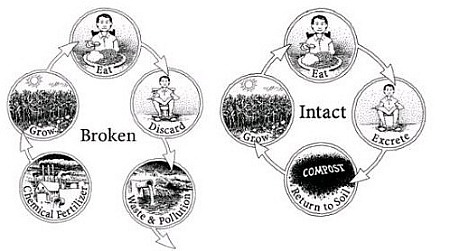
image source
When it comes to human excrement, it doesn’t take more than a bit of an effort to view it as a rich source of nutrients (which almost sounds like food) rather than the pile of crap we’ve learned to treat it as. Clearly, in its original state it is nothing more than a nasty, smelly problem, and a potential source of further problems, such as insects and infections, if not taken care of properly. Unfortunately, some seemingly “proper” treatment methods are responsible for even bigger problems.
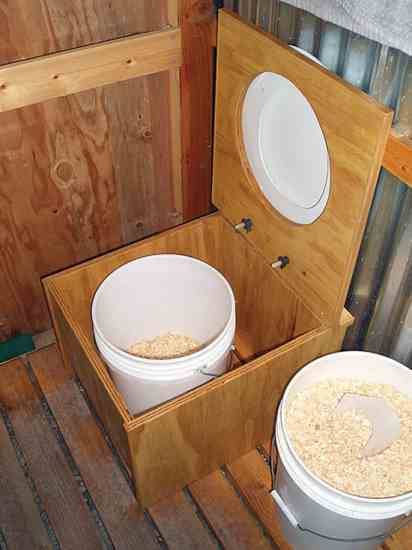
image source
The Bucket Chuck-it System
Doing a search on composting toilets will give you a good variety of ways to deal with our feces. The basic idea is always the same: covering our excrement with carbon-rich material will give it the optimal C:N (carbon : nitrogen) ratio for composting, while preventing the exposure to the air, thus keeping the smell and bugs in check. Probably the most common system for this is the two-chamber solution, where a full chamber has time to decompose while the other one is being filled over months. It is a good system, though it requires some construction work to set it up. But where would you go in the meantime? Or suppose you've just arrived on your newly acquired piece of property, without any structures whatsoever, and want to do an observation over the next few weeks. The bucket system is the ideal solution.
Probably the humanure composting system that requires the least infrastructure is the bucket. It’s just as simple as it sounds: a five-gallon bucket with an optional toilet seat on top, and a bag of sawdust on the side. Because of its minimal size, it is inevitable that it must be emptied once a week, at least. Initially, this might seem like a disadvantage. However, taking the bucket to the compost, dumping it out, covering it with some more carbon rich material, then rinsing out the bucket and dumping the water on the pile, can all be done in under ten minutes by one person. And because of the shallow depth of the bucket, it’s fairly easy to ensure that everything is 100% covered, at all times. For this reason I have found this bucket solution to be cleaner, less smelly, and less frequented by insects than the elaborate two-chamber composting toilets. So much so, that it’s even a practically feasible system for indoor use, as it can be seen on this photo of my friend's composting toilet in Hungary. Isn’t it pretty?
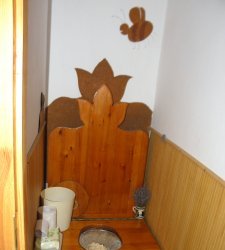
And Once the Bucket is Full...
Don't wait till it's full! It's much easier to carry and empty it out if it is only about ¾ full. And yes, it needs to have a composting pile prepared, with more carbon-rich material on the side, such as straw. I’ve once had the pleasure to build a so called “Humanure Hacienda,” straight from Joseph Jenkins’ Humanure Handbook, a highly recommendable source on this subject. There the bucket can be emptied on the pile in the left chamber and covered with straw from the dry section in the middle. When that chamber is full, which should take at least a year, the right one can be used while the left side is left alone to decompose. After the second year, the first chamber is ready to be emptied. This compost is safe to use on plants whose edible parts don’t come in contact with the compost, such as fruit trees, hazelnuts, or even corn.
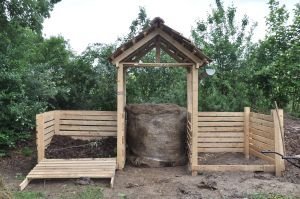
Of course it should be noted, that before the two years are up, the compost should be given its proper respect. Don't mix it with other compost, have a certain sets of tools (shovels pitchforks, etc.) designated for the humanure compost only, and even once it is ready for use, don't fertilize your carrots or cabbages with it.
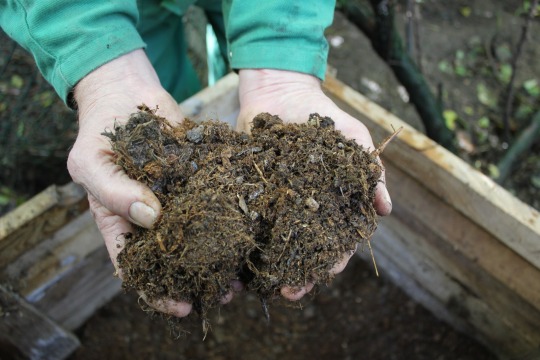
image source
All in all, I consider this the most flexible and most efficient way of dealing with one of our most ubiquitous products. It can be as simple as a bucket and a compost pile, or it can be as fancy and high-end as the structures in the photos. Of course, they are not the only type of sustainable toilets around, so stay tuned for more insights into humanure composting.
sources: 1, 2, 3, 4, 5, 6
3 notes
·
View notes
Text
GUYS QUICK
GUYS GUYS GUYS GAYS-
WE HAVE A PROBLEM VERY SERIOUS FOR PLANT PARENTS
okay so basically we are running out of soil pls help we are useless unless the government signs an agreement with a very nice man driving around to get people more aware. please take this into consideration bc no soil means no more plants.
so far 72 nations have agreed and signed but we need more as scientists believe in 60years we wont have much more than 100 gardens of soil. (not much in a sense)
aaaaaa please no soil = no plants aaa
go to savesoil.com to learn more about this
2 notes
·
View notes
Text
Biochar gives soil a healthy boost - Futurity
0 notes
Text
That we can repair damage to fragile arid landscapes, and improve the fertility of some of the most marginal land on the planet.
"Soil: The incredible story of what keeps the earth, and us, healthy" - Matthew Evans
#book quote#soil#matthew evans#nonfiction#repair#fragile#arid#landscape#fertility#soil fertility#marginal
0 notes
Text
Where once we were all pretty much farmers, or very close to the land, and we rotated crops, studied yields, used livestock as land fertility aids and worshipped soil gods over lifetimes, not just financial years, now we just ring up the agronomist and order NPK. Where we once all felt, in our hands and backs and stomachs, the health of the soil that nurtured us, now we look at spreadsheets and averages and statistically relevant results. For a while, we lost the gratitude our forebears had for the soil they worked, the land they trod, the wisdom they garnered by growing stuff and watching the earth with more than passing interest, and more of a survival instinct.
"Soil: The incredible story of what keeps the earth, and us, healthy" - Matthew Evans
#book quotes#soil#matthew evans#nonfiction#farmers#farming#crop rotation#crop yields#livestock#soil fertility#deities#lifetime#financial year#agronomist#agronomy#npk#nitrogen#phosphorus#potassium#soil health#spreadsheets#statistics#gratitude#forebears#ancestors#survival
0 notes
Text
PBL’s Seaweed Fertilizer: Offers Sustainable Crop Growth Benefits.
PBL is a leading manufacturer and supplier of seaweed fertilizer, a specialty product that provides an eco-friendly and effective solution for agricultural needs. Our product is made from high-quality seaweed rich in nutrients, which helps enhance soil fertility, promote plant growth, and improve crop yields. By choosing PBL, you can be assured of a sustainable choice that supports eco-friendly farming practices. We are committed to providing excellent customer service, and our competitive prices make us the go-to choice for premium agricultural solutions. Choose PBL for top-notch seaweed fertilizer that nurtures your crops and cultivates success.

#seaweed fertilizer#sustainable agriculture#crop growth#PBL#affordable#high-quality#eco-friendly#soil fertility#maximum yields
1 note
·
View note
Text
Moving towards more advanced agricultural practices.
The exciting comprehensive reports digital series delivers a deep dive of interactive content with a look across specific segments as agriculture evolves towards more advanced practices.
Water, Technology, & Sustainability -Read Report
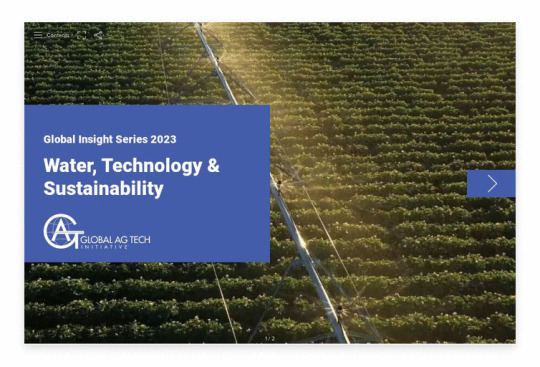
Climate Smart Farming -Read Report
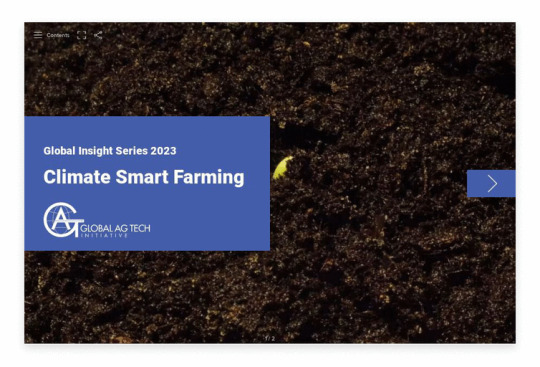
Biological Crop Protection - Read Report
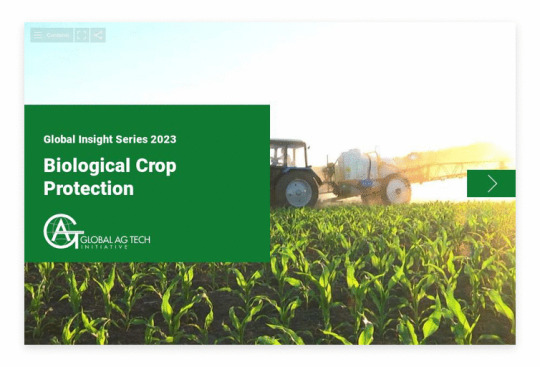
Soil Health - Read Report

Want to be represented in the Global Insight Series?
Get in touch with us today.

#advanced agricultural practices#soil science#water resources#agriculture#soil fertility#biodiversity
0 notes
Link
..
1 note
·
View note
Text
Best advice:
“Always be patient with your compost and yourself.”

#compost#soil#soil creation#community composting systems#soil health#biodiversity#biodynamic#polyculture#food systems#atlanta urban ag#soil fertility#soil food web#maurice small
54 notes
·
View notes
Text
Global Nutrient Recycling Market Is Estimated To Witness High Growth Owing To Increasing Focus on Sustainable Agriculture
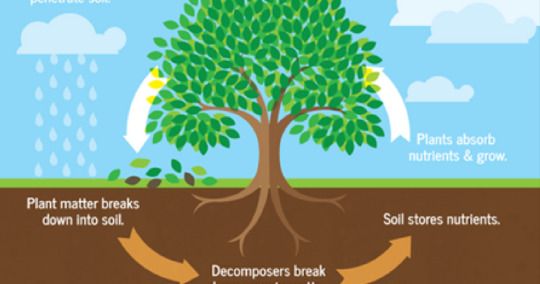
The global Nutrient Recycling Market is estimated to be valued at US$ 4.98 billion in 2023 and is expected to exhibit a CAGR of 5.9% over the forecast period 2023 to 2030, as highlighted in a new report published by Coherent Market Insights.
A) Market Overview: The Nutrient Recycling Market involves the recovery and reuse of essential nutrients from various waste sources, such as wastewater, agriculture waste, and food waste. This process helps in reducing the environmental impact of nutrient pollution and plays a significant role in achieving sustainable agriculture. The market offers various products and technologies that enable efficient extraction of nutrients and their conversion into valuable fertilizers. The need for nutrient recycling products and technologies arises from the growing global population and the increasing demand for food. Traditional farming practices lead to the depletion of nutrients from the soil, resulting in lower crop yields and reduced soil fertility. Nutrient recycling solutions provide an effective way to replenish nutrients in the soil and enhance agricultural productivity.
B) Market Key Trends: One key trend observed in the Nutrient Recycling Market is the adoption of innovative technologies for nutrient recovery. Companies are investing in research and development activities to develop advanced methods that can efficiently extract nutrients from waste streams and convert them into high-quality fertilizers. For example, Ostara Nutrient Recovery Technologies Inc. has developed a proprietary technology that recovers phosphorus from municipal wastewater and converts it into Crystal Green®, a slow-release fertilizer. This innovative technology not only reduces the environmental impact of nutrient pollution but also provides a sustainable source of phosphorus for agricultural use. Similar advancements are being made by other key players in the market, such as Nutrient Recovery & Upcycling LLC, Cambi AS, AgriProtein Holdings Ltd., and Anuvia Plant Nutrients.
C) PEST Analysis: Political: Governments worldwide are implementing regulations and policies to promote sustainable agriculture practices and reduce nutrient pollution. For instance, the European Union has set limits on the use of chemical fertilizers and encourages the adoption of nutrient recycling technologies. Economic: Increasing concerns about food security and the need for efficient resource utilization are driving the demand for nutrient recycling solutions. These solutions help in reducing fertilizer costs and improving crop yields, thereby providing economic benefits to farmers. Social: There is a growing awareness among consumers about the environmental impact of conventional farming practices. As a result, there is a rising demand for sustainably produced food, which drives the adoption of nutrient recycling technologies in the agriculture industry. Technological: Advancements in technology have led to the development of innovative nutrient recovery and recycling techniques. These technologies enable efficient extraction of nutrients from various waste sources and their conversion into valuable fertilizers, promoting sustainable agriculture practices.
D) Key Takeaways: - The global Nutrient Recycling Market is expected to witness high growth, exhibiting a CAGR of 5.9% over the forecast period, due to increasing focus on sustainable agriculture. - North America is expected to dominate the market during the forecast period, driven by strict environmental regulations and initiatives promoting nutrient recycling in countries like the United States. - Key players operating in the global Nutrient Recycling Market include Ostara Nutrient Recovery Technologies Inc., Nutrient Recovery & Upcycling LLC, Cambi AS, AgriProtein Holdings Ltd., Anuvia Plant Nutrients, and more. These companies are actively engaged in research and development activities to develop advanced nutrient recovery technologies and expand their market presence. Overall, the Nutrient Recycling Market holds significant potential for sustainable agriculture practices and offers promising opportunities for companies operating in this space. The adoption of nutrient recycling solutions can help address the challenges of nutrient pollution, enhance soil fertility, and contribute to the long-term sustainability of the agriculture industry.
#Soil Fertility#Coherent Market Insights#Agrochemicals#Nutrient Recycling Market#Chemical and Materials#Sustainable Agriculture
0 notes